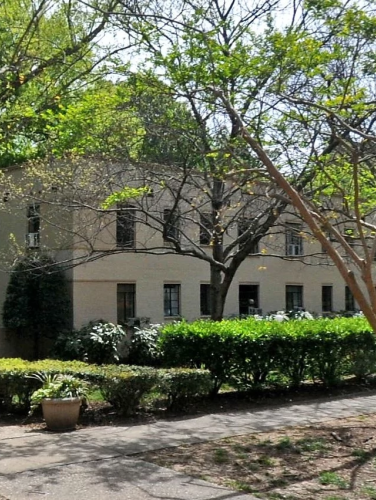
Myrtle Square Apartments
(ca. 1939)
The Art Moderne styled Myrtle Square Apartments remain as Charlotte’s oldest garden court apartment complex.
1121 Myrtle Ave, Charlotte, NC 28203
By the 1930s, Charlotte was a leading manufacturing and trading center of the Southeast and had surpassed Charleston, South Carolina, as the largest city in both Carolinas. Inexpensive labor, an abundance of raw materials, and an extensive railroad network that extended Charlotte’s trading reach from Washington D.C. to New Orleans all placed the Queen City at the very center of a manufacturing region of nearly 800 textile mills and various other industrial plants. The expanding economic base attracted thousands of new workers, leading to an unprecedented period of population growth. During the boom years of the 1920s, Charlotte experienced a 78% population explosion, growing from 46,388 to 82,675 citizens in the span of one decade. By 1940, the city’s population reached 101,000. That increase necessitated more housing. Although apartments had appeared in Charlotte by the early 1900s, multi-unit housing did not catch on until the 1920s.
Property Quick Links
The earliest apartments in the city were located downtown, coinciding with the exodus of single-family residences to the Dilworth and Myers Park suburbs. But apartment complexes soon began to appear anywhere public transportation was readily accessible. The most popular form of early apartment design was the quadraplex, a single structure divided into four separate units. By the late 1920s, apartment living in Charlotte had expanded into multilevel rectangular block buildings such as the Frederick Apartments on North Church Street and the Tryon House apartments at 508 North Tryon Street. In 1926, Dilworth’s Addison Apartments became the city’s first high-rise apartment complex. Development of the Dilworth neighborhood continued steadily, but the interior of the triangular land parcel formed by Myrtle, Lexington, and Mount Vernon Avenues remained unsold and undeveloped until December 1937, when that vacant area was purchased by Myrtle Square Apartments, Inc. The new owners hired F.N. Thompson Company in June 1938 to construct what would become Charlotte’s most sophisticated garden court community.
The existence of Myrtle Square Apartments is remarkable given the convergence of two significant factors – the dearth in construction in the 1930s due to the Depression, and the relatively short life of the Art Moderne architectural style. Those two factors contributed to a small window of time during which a building like Myrtle Square could have been constructed. By the time Charlotte’s residential construction market started to rebound at the end of the 1930s, and the construction of garden court apartments accelerated after WWII, Art Moderne had already outlived its popularity. Apartment construction thereafter was characterized by “superblock” complexes using traditional or revivalist motifs devoid of any particular architectural distinction. As a result, the Myrtle Square Apartments are singular as Charlotte’s oldest garden court complex and a rare local example of Art Moderne residential architecture.

